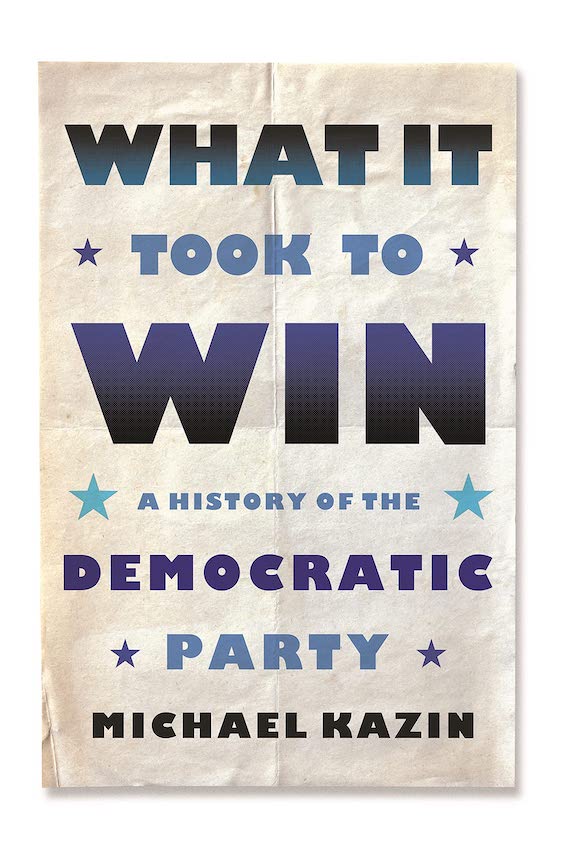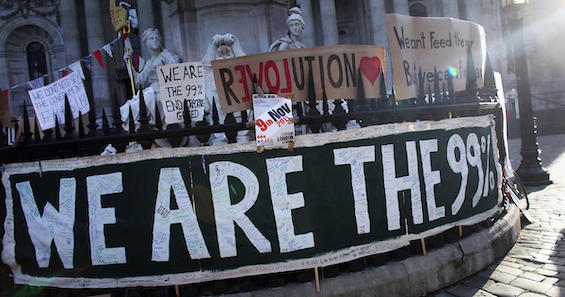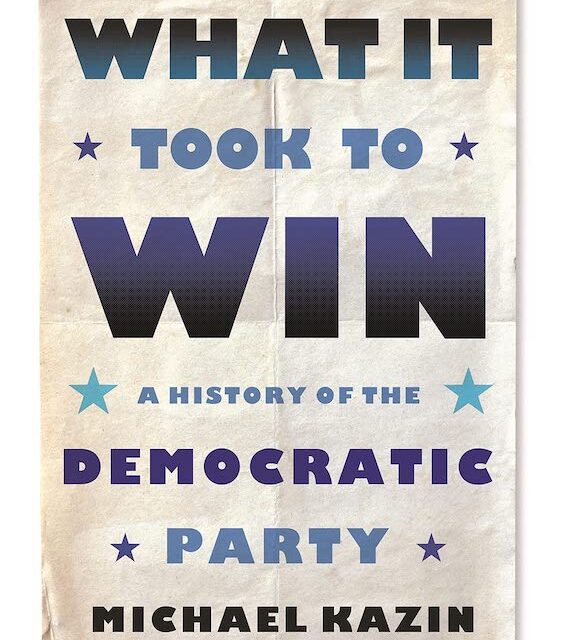
In his sweeping new history of the Democratic Party, historian Michael Kazin finds that “what it took” for Democrats to win historically was an outspoken commitment to moral capitalism. The term, coined in 1990 by another historian, connotes “a form of political economy . . . that promised everyone, owner or worker, a fair share.” It was this commitment, Kazin asserts, that led to the iconic victories of Andrew Jackson, Woodrow Wilson, Franklin Roosevelt, and Lyndon Johnson. To put it in the simplest terms, “[w]hen Democrats made a convincing appeal to the economic interests of the many, they usually celebrated victory at the polls.”
Two competing tendencies in moral capitalism
Kazin sees “two different and, at times, competing tendencies” in moral capitalism. “The first,” he writes, “is a harsh critique of concentrated elite power—’monopoly.'” The second “attacks the oppression of Americans in the workplace, whether by poor working conditions, bad wages, insecure employment, a ban on union organizing, or other indignities.” The tension between these two tendencies has, at times, weakened the Democratic Party and contributed to its losses at the polls.
What It Took to Win: A History of the Democratic Party by Michael Kazin (2022) 250 pages ★★★★☆

The evolving history of the Democratic Party
In the 19th Century
In the charged rhetoric of political campaigns, Democratic candidates traditionally paid homage to Thomas Jefferson as the leading light of their party. Somewhat closer to the truth, many historians instead credit Andrew Jackson as the party’s founder. Kazin sets them all straight. It was the country’s eighth president, Martin Van Buren, who assembled the pieces of the coalition that became the Democratic Party. As Jackson’s Secretary of State and then Vice President, Van Buren was the nuts-and-bolts politician who made the general’s victories possible and set the course for the Democratic Party during much of the 19th century. Later, Illinois Senator Stephen A. Douglas and New York financier August Belmont built on the foundation Van Buren had laid.
Although Kazin cites the efforts of numerous individual officeholders and backroom operatives, he focuses his history on a handful of people who were most instrumental in building the Democratic Party as we know it today. In the late 19th and early 20th centuries, the most influential was three-time Presidential candidate William Jennings Bryan. “Woodrow Wilson would erect his New Freedom, Franklin D. Roosevelt his New Deal, and Harry Truman his Fair Deal on the foundation of alliances and policies Bryan had laid.”
In the 20th Century
The emergence of organized labor
In the 1920s, as Democrats languished under a succession of three lackluster Republican Presidents, four Democratic activists took up the task of rebuilding the party. Four-term New York Governor and 1928 Presidential candidate Al Smith was the best-known. Behind the scenes, three standout women activists, Belle Moskowitz, Frances Perkins, and Eleanor Roosevelt, helped institutionalize the party and focus its commitment on the principles of moral capitalism. The groundwork they laid bore fruit in the 12-year span of Franklin Roosevelt’s transformative Presidency.
Under FDR, the most instrumental role in the Democratic Party passed to organized labor and its champions in Congress and the White House. The emergence of the Congress of Industrial Organizations (CIO) set the course for labor’s pivotal role in the Democratic victories of the 1930s and beyond. (“No major piece of domestic legislation that Democrats enacted from the New Deal through the 1960s succeeded without the backing of labor officialdom,” Kazin asserts.) Two individuals were central figures in these developments: New York Senator Robert F. Wagner and Sidney Hillman, head of the Amalgamated Clothing Workers of America.
In Kazin’s telling, the outstanding contributors to Democratic success in the 1950s and 60s were Minnesota Senator Hubert Humphrey, New York Congressman Adam Clayton Powell Jr., and Texas Senator and later President Lyndon B. Johnson. Their work to enact civil rights legislation brought the Democratic Party into line with its values, cementing an enduring commitment to multi-racial, multi-ethnic policies that have lasted to the present day.
Two steps backward: the Democratic Leadership Council
Sadly, the resurgence of the Republican Right in the 1970s, culminating in the election of Ronald Reagan, dramatically undermined Democrats’ self-confidence. Established by activist Al From in 1985, the Democratic Leadership Council (DLC) led a sharp turn to the right to accommodate the Republican wave by appealing to the “middle class.” Republican success in decimating organized labor in the 1970s and 80s sharply reduced the opposition to the DLC within the Democratic Party.
Then-Arkansas Governor Bill Clinton and Senators Joe Biden and Al Gore were the DLC’s leading lights. Their efforts led to Clinton’s election as President in 1992—and to disastrous policies such as mass incarceration, “welfare reform,” financial deregulation, and the repeal of Glass-Steagall. Republicans could not have done a better job of shifting the country to the right. These policies played a large role in causing the Great Recession of 2007 to 2010 and further moving the Democratic Party away from moral capitalism. Attempts by Rev. Jesse Jackson Sr. and others to shift the party back toward a commitment to social and economic justice foundered.
In the 21st century
In the deeply polarized politics of the past two decades, Democrats have fared reasonably well electorally. The Presidency has shifted from one party to the other with regularity. But, even when controlling the White House, the party has failed to enact major legislation (other than the Affordable Care Act, or Obamacare) that would persuade a large majority of voters the Democratic Party is on their side.
Much of what has been accomplished, including Obamacare, has been a result of Nancy Pelosi‘s skill at shepherding legislation through the shoals of opposition in Congress. Alienated by the meager accomplishments of the Democratic Party since 1979, a new wave of progressive activists, including Vermont Senator Bernie Sanders and New York Congresswoman Alexandria Ocasio-Cortez, has emerged to press for more forward-looking policies. Unfortunately, despite outspoken support for many of these policies by President Joe Biden, wafer-thin Democratic majorities in the House and Senate have stymied their efforts.
The political context of the past half-century
Kazin focuses tightly on the Democratic Party as an institution, which is understandable and appropriate given the history he set out to tell. But it’s a story that veers out of context. In lamenting the failure of the party to champion the moral capitalism he values over the past half-century, he largely ignores the conservative counter-revolution against the liberal order of 1933-68. Beginning early in the 1970s, Big Business and the men who profited so handsomely from it bankrolled what in time became a massive Right-Wing infrastructure of think tanks, lobbying firms, consulting agencies, and conservative law schools.
Together, these institutions elected Ronald Reagan and his ideological successors (George W. Bush and Donald Trump), stuffed the court system with hordes of Right-Wing judges, and forced the Democratic Party onto the defensive. Today, well into the 21st century, we can see their handiwork exposed in vivid relief in the rulings of a reactionary and highly politicized Supreme Court.
The impact on the Democratic Party of this political sea change was immense. As Kazin notes, “the opportunity was lost to forge a new coalition of working- and lower-middle-class people of all races who shared, despite their mutual suspicions, a desire for a more egalitarian order. It has yet to be regained.”
Today, there is no “Democratic Party”
To some degree, every modern mass political party is a coalition. Historically, both the major American parties have necessarily followed this pattern, with right and left wings pulling in opposite directions and disparate forces demanding a focus on their special interests. Today, as the Republican Party drifts ever more tightly into uniformity, with its liberal wing forced out of power, the Democratic Party has devolved into chaos. T0 my mind, there is, properly speaking, no “Democratic Party.” The phrase has become a term of art. What passes for a party is a congeries of single-issue and identity-based interest groups with links of varying durability to the party’s traditional core values championing social democracy.
Republicans can easily sum up what they’re about in a single sentence. (“We believe in small government, local control, the power of free markets, and Christian authority.”) Democrats cannot, because the numerous factions that make up the Democratic coalition agree on only one thing: they don’t like Republicans or the policies Republicans impose when they’re in power. Despite its impressive infrastructure (DNC, DSCC, DCCC, DLCC, and state party organizations), the oldest mass party in the world has become a shadow of its former self.
About the author

Michael Kazin is a Professor of History at Georgetown University in Washington, DC. He is the author of seven nonfiction books and co-editor of Dissent magazine. He holds a BA from Harvard, an MA from Portland State University, and a PhD in History from Stanford. As a Harvard student he was a leader in Students for a Democratic Society.
For more reading
Two books cast light on the themes Michael Kazin writes about: Shattered: Inside Hillary Clinton’s Doomed Campaign by Jonathan Allen and Amie Parnes (Why Hillary Clinton lost the 2016 election) and Pelosi by Molly Ball (A critical but admiring biography of Nancy Pelosi).
You might also enjoy:
- Top 10 nonfiction books about politics
- Top 20 popular books for understanding American history
- 20 top nonfiction books about history
And you can always find my most popular reviews, and the most recent ones, plus a guide to this whole site, on the Home Page.


























